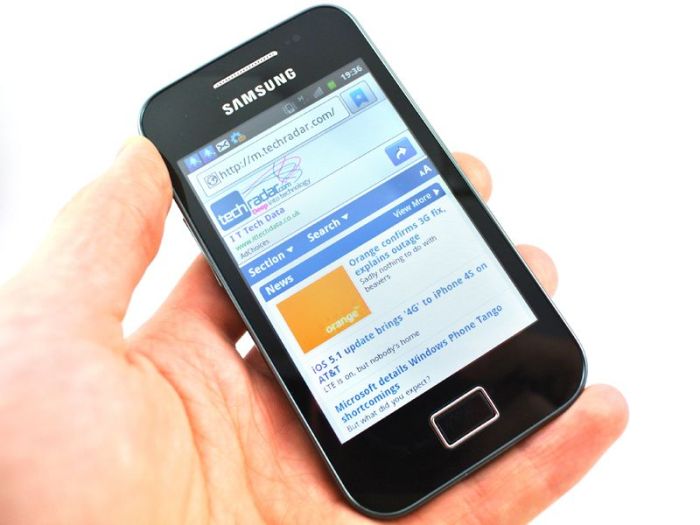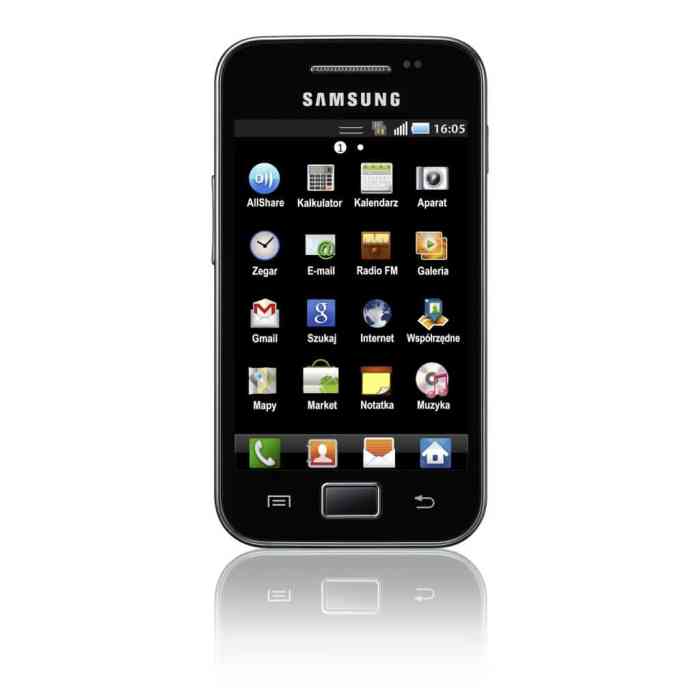Samsung Galaxy Ace Full Specification
Samsung Galaxy Ace: A Retrospective: Samsung Galaxy Ace Full Specification
Samsung galaxy ace full specification – Released in 2011, the Samsung Galaxy Ace carved a niche in the burgeoning smartphone market. Targeting budget-conscious consumers and those seeking a simple yet functional Android experience, it offered a compelling entry point into the world of mobile technology. Its success lay in its balance of affordability and key features, differentiating it from other entry-level devices of the time.
Introduction to Samsung Galaxy Ace
The Samsung Galaxy Ace launched as a budget-friendly Android smartphone, aiming to capture a significant portion of the entry-level market. Its target audience consisted primarily of first-time smartphone users and those seeking an affordable alternative to higher-end models. Key features that set it apart included its compact size, user-friendly interface, and access to the Google Play Store, offering a wide range of applications.
Technical Specifications: Display and Processor

Source: futurecdn.net
The Galaxy Ace’s performance and battery life were heavily influenced by its processor. Understanding its specifications allows for a comparison with contemporary devices and an assessment of its capabilities.
Finding the full specifications for the Samsung Galaxy Ace can be a bit of a quest, given its age. However, comparing its features to more modern Samsung models offers a useful perspective. For instance, looking at the advancements made, one might consult the detailed specifications for a more recent device like the samsung galaxy a91 specification to see the evolution in processing power, camera capabilities, and screen technology.
This comparison helps highlight the significant leaps in mobile technology since the Galaxy Ace’s release.
| Screen Resolution | Screen Size | Processor Type | Clock Speed |
|---|---|---|---|
| HVGA (480 x 320 pixels) | 3.5 inches | ARM Cortex-A8 | 800 MHz |
The 800 MHz ARM Cortex-A8 processor, while modest by today’s standards, provided acceptable performance for basic tasks like browsing, messaging, and running lightweight applications. Compared to competitors like the HTC Wildfire which also utilized an 800MHz processor but with a different architecture, the Galaxy Ace offered a comparable user experience within its price range. The processor’s efficiency contributed to reasonable battery life, although intensive usage would naturally drain the battery quicker.
Technical Specifications: Memory and Storage
The Galaxy Ace’s memory and storage capabilities significantly impacted its user experience, particularly concerning multitasking and application storage.
| RAM | Internal Storage | Expansion Options |
|---|---|---|
| 512 MB | 150 MB (user-accessible) | MicroSD card (up to 32 GB) |
The limited 150 MB of user-accessible internal storage was a significant constraint for users at the time. Many applications required considerable space, leading users to rely heavily on microSD card expansion. The 512 MB of RAM allowed for basic multitasking, but more demanding applications might cause noticeable lag or slowdowns.
Technical Specifications: Camera and Connectivity
The Galaxy Ace’s camera and connectivity features reflected the technological landscape of 2011. Understanding these specifications provides insight into its capabilities and limitations.
- 5-megapixel rear camera
- No front-facing camera
- Autofocus
Connectivity options included Wi-Fi, Bluetooth, and cellular data (GSM/UMTS). Compared to modern smartphones, the camera’s resolution and lack of a front-facing camera were significant limitations. Image quality was often affected by low light conditions, and features like HDR were absent.
Operating System and Software

Source: tekimobile.com
The Galaxy Ace’s operating system and pre-installed applications shaped the user experience and influenced its software update lifecycle.
The Samsung Galaxy Ace originally shipped with Android 2.3 (Gingerbread). Pre-installed applications included the standard Google suite (Gmail, Maps, etc.), along with Samsung’s own suite of applications. While the device received some software updates, their lifespan was limited by the hardware’s capabilities and the Android update policies of the time.
Battery Life and Usage, Samsung galaxy ace full specification
Battery life was a crucial aspect of the user experience. Understanding the battery technology and its performance under different usage scenarios provides a comprehensive overview.
The Galaxy Ace featured a Lithium-ion battery with a capacity that provided approximately 6 hours of talk time and up to 300 hours of standby time. This battery life was considered average for smartphones of its era. Compared to contemporary smartphones with more power-efficient processors and larger batteries, the Galaxy Ace’s battery life was shorter, requiring more frequent charging.
Physical Design and Dimensions
The Galaxy Ace’s physical attributes contributed significantly to its overall user experience and market appeal. Its compact design made it easy to handle, a key factor in its popularity.
The Samsung Galaxy Ace featured a compact and lightweight design, using plastic materials. Its dimensions were relatively small compared to modern smartphones, resulting in a device that was easy to carry and operate with one hand. This design aesthetic was typical for smartphones in its era, prioritizing functionality over sleek aesthetics.
Legacy and Impact
The Samsung Galaxy Ace played a significant role in the popularization of smartphones, particularly in emerging markets. Its affordability and accessibility broadened the reach of mobile technology to a wider audience.
The Galaxy Ace holds a significant place in Samsung’s product history as a successful entry-level device that contributed to the company’s growth. Its impact on the smartphone market was particularly notable in regions where affordability was a key factor in smartphone adoption. The device’s success demonstrated the market demand for affordable yet functional Android smartphones.
Essential Questionnaire
Was the Samsung Galaxy Ace waterproof?
No, the Samsung Galaxy Ace was not waterproof.
Did the Samsung Galaxy Ace have a touchscreen?
Yes, it featured a capacitive touchscreen.
What was the main competitor to the Samsung Galaxy Ace at the time of its release?
Several phones competed, including models from HTC and other manufacturers, depending on the specific region and market segment.
Could you upgrade the operating system significantly beyond its initial release?
While some updates were likely provided, the lifespan of significant OS upgrades was limited by the device’s hardware capabilities.





















